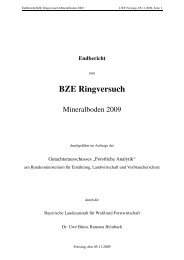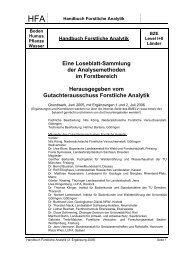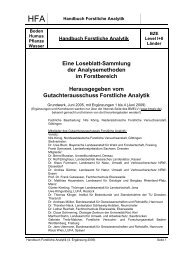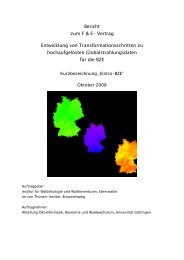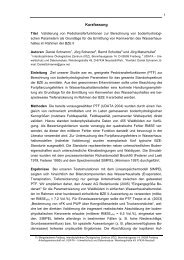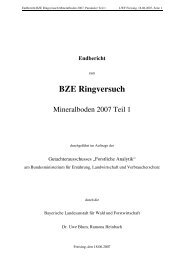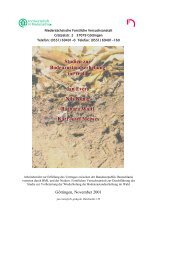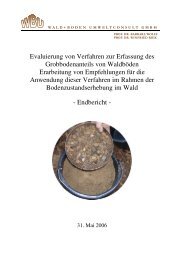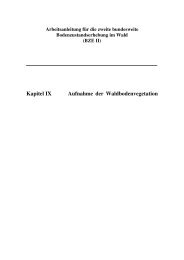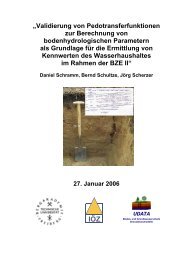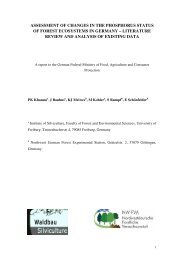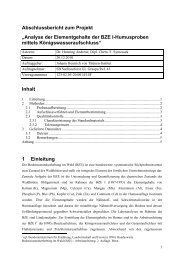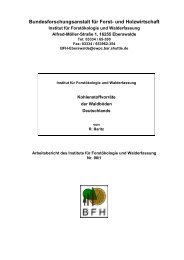assessment of changes in the phosphorus status of forest ...
assessment of changes in the phosphorus status of forest ...
assessment of changes in the phosphorus status of forest ...
You also want an ePaper? Increase the reach of your titles
YUMPU automatically turns print PDFs into web optimized ePapers that Google loves.
phase: a) anion replacement to enhance desorption, b) complex<strong>in</strong>g <strong>of</strong> cations b<strong>in</strong>d<strong>in</strong>g<br />
P to release P, c) hydrolysis <strong>of</strong> cations b<strong>in</strong>d<strong>in</strong>g P to release P and d) dissolv<strong>in</strong>g action<br />
<strong>of</strong> acids. Therefore, <strong>the</strong> selection <strong>of</strong> a soil test for P should depend on extract<strong>in</strong>g P<br />
from certa<strong>in</strong> chemical forms <strong>of</strong> <strong>in</strong>terest based on <strong>the</strong> soil characteristics.<br />
Some <strong>the</strong>se methods are reviewed below:<br />
Among <strong>the</strong> use <strong>of</strong> different extractants <strong>the</strong> use <strong>of</strong> water to extract P from soils is<br />
restricted to soils, to which very high amounts <strong>of</strong> P have been added and are present<br />
<strong>in</strong> easily dissolved forms <strong>in</strong> soils. This is not <strong>the</strong> case for <strong>forest</strong> soils <strong>in</strong> general. Only<br />
small amounts <strong>of</strong> soil P can be extracted by water creat<strong>in</strong>g problems <strong>in</strong> chemical<br />
analysis. However despite <strong>the</strong> very low absolute values obta<strong>in</strong>ed by water extraction,<br />
<strong>the</strong>se values relate to <strong>the</strong> <strong>in</strong>tensity parameter <strong>of</strong> P availability <strong>in</strong> soils and have been<br />
used <strong>in</strong> relat<strong>in</strong>g <strong>the</strong>m to capacity parameters <strong>of</strong> soil P obta<strong>in</strong>ed by us<strong>in</strong>g o<strong>the</strong>r methods<br />
(see Ulrich and Khanna 1968). The limitations <strong>of</strong> its wide scale use are both <strong>the</strong><br />
cumbersome extraction procedures to achieve equilibrium solution phases and <strong>the</strong> use<br />
<strong>of</strong> such methods for huge number <strong>of</strong> survey type soil samples.<br />
One <strong>of</strong> <strong>the</strong> most common methods used for <strong>forest</strong> soils is <strong>the</strong> so called Bray method<br />
(Bray and Kurtz 1945). The extractant is a mixture <strong>of</strong> HCl and NH4F, where F acts to<br />
complex <strong>the</strong> Al and Fe and <strong>the</strong> P bound to <strong>the</strong>m is released. The amount <strong>of</strong> acid added<br />
is sometimes varied depend<strong>in</strong>g upon <strong>the</strong> form <strong>of</strong> P to be extracted. The extractant with<br />
low HCl concentration is called <strong>the</strong> Bray1 method. This method is specifically<br />
designed to be used <strong>in</strong> acid soils. Bray 1 and Bray 2 (high HCl concentration)<br />
methods are commonly employed for <strong>forest</strong> soils, especially those with high amounts<br />
<strong>of</strong> organic matter. This method has been used to show short term <strong>changes</strong> <strong>in</strong> <strong>the</strong> soil<br />
due to treatments such as fire (Romanya et al. 1994), soil heat<strong>in</strong>g (Serrasolsas and<br />
Khanna 1995), or fertilizer additions. However, Compton and Cole (1998) reported<br />
that alder stands which had higher P dynamics (uptake, litterfall content, resorption<br />
values) than Douglas fir stands, had lower Bray P value and total P <strong>in</strong> <strong>the</strong> soil,<br />
suggest<strong>in</strong>g that <strong>the</strong> quantification <strong>of</strong> an available P pool alone does not adequately<br />
reflect P supply <strong>in</strong> <strong>forest</strong> stands. When nutrient pools are small, <strong>the</strong> flux through <strong>the</strong>se<br />
pools, must be considered as well to obta<strong>in</strong> a realistic picture <strong>of</strong> nutrient supply from<br />
that pool.<br />
For calcareous and alkal<strong>in</strong>e soils <strong>the</strong> method commonly used employs 0.5 M NaHCO3<br />
solution at a pH <strong>of</strong> 8.5 to extract available soil P (Olsen et al. 1954). This extractant<br />
decreases calcium <strong>in</strong> solution (through precipitation <strong>of</strong> calcium carbonate), and thus<br />
60



